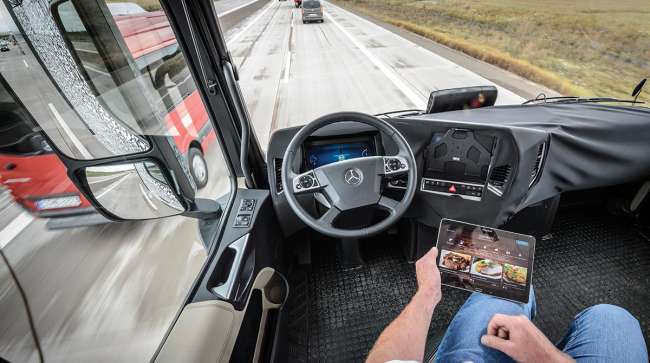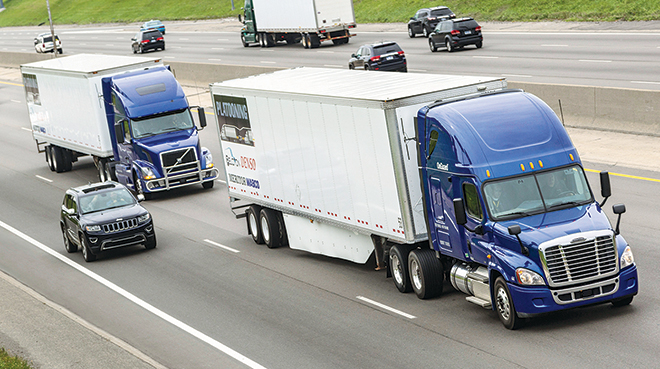Opinion: Why Autonomous Trucks Won’t Cost Jobs Anytime Soon

With all the media buzz about autonomous vehicles, it was only a matter of time before autonomous trucks became part of the hype cycle. Take autonomous trucks one step further and some are already predicting job losses in transportation.

Allen
By all accounts, autonomous trucks will become a reality in the next several years and will probably be common on the roads within 10 years. In October 2016, Uber-owned Otto (now part of Uber’s Advanced Technology Group) made its first delivery via autonomous truck — 50,000 cans of beer, in Colorado.
Others have followed. But the trucks still require a driver, as their autonomous features are only used for highway driving. We are a long way from a fully automated, end-to-end delivery process. (One possible wrinkle: a pending lawsuit alleging that Otto was created based on technology stolen from Waymo.)
SHARE YOUR THOUGHTS: Comment on autonomous trucks on Facebook
In addition to drivers, autonomous trucks will still require people to perform pre- and post-trip inspections, manage the loading and unloading of cargo, work with on-site contacts on delivery and receipt details and repair vehicles and delivery equipment. Even when vehicles are fully autonomous (with no one required in the driver’s seat — a longer-term goal), you’ll likely still need a person in the cab to manage the transportation and delivery process and act as a backup in case something goes awry with the technology. Plus, new jobs will be created to develop and support autonomous driving technology — including electronic logging devices, or ELDs.
A recent blog post from the Brookings Institution, a Washington, D.C.-based think tank, debunked the theory that autonomous trucks will lead to job losses, pointing to Department of Labor figures showing that truck drivers and delivery drivers have a lower-than-average degree of automation. Positions with a higher degree of automation are more likely to experience job losses due to automation. This includes office clerks, cashiers and receptionists.
Also, consider that truck driver is the most common occupation in 29 states. It would take many years to replace all of those 3.5 million drivers with autonomous trucks.
Brookings suggests that truck maintenance — and repair jobs, in particular — aren’t going anywhere, as those positions are highly specialized and thus are difficult to automate.

Two trucks in a platooning demonstration. (Meritor Wabco)
With all that said, some jobs will certainly change. Drivers will need to keep their skills fresh through professional development and training. Technology skills — such as telematics proficiency — will likely become more important even as driving skill becomes less important. It’s possible that even the occupation name (“Driver”) may change over time to something less focused on driving and more focused on the supply chain function they fulfill, which is really transportation and delivery. Remember the old adage about buggy whip manufacturers: They went under because they didn’t realize they were really in the transportation business until it was too late to adapt.
There are also myriad regulatory hurdles to consider. In April 2017, the Federal Motor Carrier Safety Administration held a public listening session on autonomous trucks. At the session, Tom Balzer, president of the Ohio Trucking Association, spoke for many when he said, “There is a gigantic void between what is reality and what is the Hollywood version of what is going on. We are a long, long way from a truly driverless truck, and I think everyone in this room knows that.”
FMCSA accepted public comments on autonomous trucks through July 17. Now it must consider what new regulations and guidelines may be needed. One big gray area is whether or how hours-of-service rules would need to change. For example, in a fully autonomous truck, with no person required in the driver’s seat, could a driver log sleeping time in the berth while the vehicle is in motion? Would two people be required in the truck in that scenario? If sleeping time were allowed, could a driver be in the vehicle for more than 11 hours? It could take years to sort out the rules. Then there are the cybersecurity issues: Imagine a scenario in which hackers or terrorists take control of a fully loaded, 40-ton semi-truck connected to a hazardous hauling vehicle in a heavily populated area.
All the talk about autonomous trucks has certainly made our industry more interesting — as if the ELD mandate hadn’t made it interesting enough. We’d be remiss in not discussing how the technology might improve operations and create new skilled jobs for U.S. citizens. There is no doubt in my mind that our industry will transition to autonomous — and then fully autonomous — trucks in our lifetime. So prepare yourself, but don’t expect any real impact anytime soon.
Allen is a more than 20-year veteran of the technology and telematics industries. MiX Telematics, which is based in Boca Raton, Fla., is a global provider of fleet and mobile asset management solutions.




